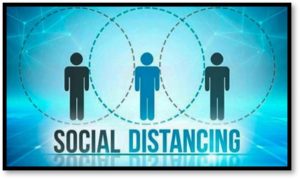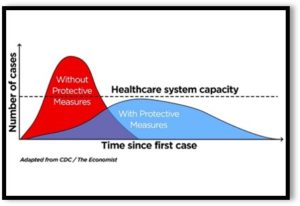Monday Author: Susanne Skinner
Social distancing is not a new concept. Doctors recommend it to their patients prior to major surgery and suggest reducing contact during seasonal flu outbreaks.
 It is usually short term, and most of us are unaffected by it. Until a few weeks ago it was not on anyone’s radar. Suddenly the world is shutting down, and people are faced with isolation and quarantine and boredom. None of us know when it will end.
It is usually short term, and most of us are unaffected by it. Until a few weeks ago it was not on anyone’s radar. Suddenly the world is shutting down, and people are faced with isolation and quarantine and boredom. None of us know when it will end.
The objective of social distancing is simple. It’s intended to reduce the probability of contact between persons carrying an infection, and to minimize disease transmission to those susceptible or not infected.
Failure to practice this common-sense approach creates chaos, fear and a pandemic. Welcome to social distancing in the time of Covid-19. It’s not just about you.
The Six-Feet Rule for Social Distancing
The general consensus is that young and healthy people are at a lower risk for suffering severe affects from coronavirus. However, those at lower risk can still infect high-risk individuals. This disease has no vaccine, increasing the level of panic.
By keeping ourselves in our homes for the next month, we limit the contact and risk to us and those around us. It means altering our daily schedules and lives and remaining six feet apart from those we do come in contact with. It’s hard, but it’s doable if everyone remains mindful of what happens if we don’t.
In Florida, the governor has closed all beaches, bars, restaurants, gyms and government buildings. Bealls, a major retailer, has also closed its doors. Doctor’s offices are closed but will take phone calls and encourage tele-chats. Hospitals have suspended non-emergency procedures.
These are extreme actions. They are meant help to flatten the curve, or rapid spread of the disease.
Flattening the Curve
In epidemiology, the idea of slowing a virus’s spread so fewer people need treatment at any given time is known as flattening the curve. It explains why countries are implementing social distancing guidelines—including a shelter-in-place order in major cities and countries.
 The curve refers to the projected number of people who will contract Covid-19 over a period of time. This is important for medical care providers, hospitals and the availability of supplies.
The curve refers to the projected number of people who will contract Covid-19 over a period of time. This is important for medical care providers, hospitals and the availability of supplies.
Depending on the virus’s infection rate it could be a steep curve, with the virus spreading exponentially. This means the count doubles at a consistent rate and the total number of cases reaches its peak within a few weeks.
Infection curves with a steep rise also have a steep decline. The virus will infect everyone who can be infected, then the numbers begin to dramatically decline
The faster the infection curve rises; the quicker the local and national healthcare systems must respond. Before long they reach their capacity to treat people. This results in new patients forced to go without beds, respirators and the basic supplies hospitals need to react to a pandemic situation.
A flatter curve assumes the same number of people ultimately get infected, but over a longer period of time. A slower infection rate means the healthcare system is less stressed and better able to respond. A flat curve means fewer sick people being turned away.
How Did We Get Here?
There are those who believe Covid-19 is a politically motivated and exaggerated virus. I actually read a social media post claiming it is lab-created by China as part of their world domination plan.
The initial outbreak in China is largely due to stealth transmissions, or cases with symptoms that were not severe enough to be noticed or cause concern.
Research predicts that about half of the world population is infected by an influenza pandemic within two years. If Covid-19 follows this assumption, 3.5 billion infections, 500 million confirmed cases, and 11.5 million deaths will occur.
This estimate assumes no immediate vaccines in the point-of-care treatment of confirmed cases.
A Picture is Worth a Thousand Words
People with undiagnosed infections often do not know they have the virus. They experience mild or even no symptoms and get better without treatment.
Depending on contagiousness and numbers, they can still expose a far greater portion of the population than would otherwise occur if they were diagnosed and quarantined.
Do Your Part
The only way to flatten the curve is through collective action.
The U.S. Centers for Disease Control and Prevention (CDC) recommends everyone wash their hands frequently and isolate themselves if they are sick.
We are in this together. I am using my time to focus on self-care, enjoying craft projects, baking and the joy of reading. I am reaching out to those far away, checking to make sure they are healthy. My Dad and sister are in lockdown. I am unable to see them, but we talk every day.
Everyone should be mindfully practicing the recommended preventatives. We’ve got this!
Do the Five Types of Prophylaxis
- HANDS: Wash them often
- ELBOW: Cough into it
- FACE: Don’t touch it
- FEET: Stay 3 to 6 feet apart
- SICK: Stay home
People of all ages and in all geographies can be infected. Those with pre-existing medical conditions (asthma, diabetes, heart and auto immune disease) appear to be more vulnerable and risk becoming severely ill.
Good hygiene and social distancing remain the best line of defense. There is a lot of misinformation out there, along with doomsday predictions and panic buying. Don’t be that person.
We’re feeling the pain of cancelled plans, separation from loved ones and a redirection of our daily routines. I’m not saying it’s easy, but it is necessary. Let’s learn from this and create a new normal.
Take care of yourself, behave yourself, and speak to your doctor if you feel ill.
More on Covid-19
- Coronavirus: What You Need to Know
- The Coronavirus and Unexpected Benefits
- Thoughts on the Coronavirus Pandemic


I have always practiced social distancing. If you remember, you probably don’t, but whatever. I have always said and will continue to say, 3 feet rule. It’s my personal space. I don’t like people in that 3 foot space. Not unless I invite you into it. Now it’s 6 feet. And I’m good with that.